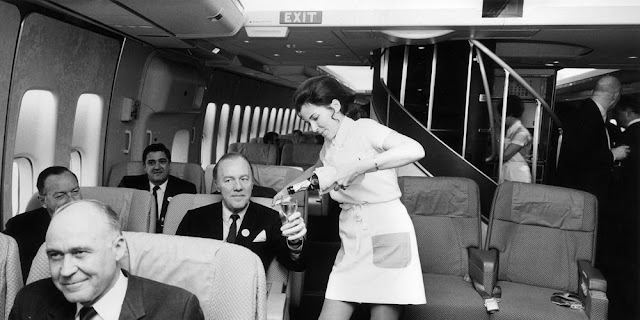Come Fly The World by Julia Cooke
Itching for an excursion, and with nowhere to go due to COVID-19 I recently read Come Fly the World by Julia Cooke, a fascinating jet-age story about the stewardesses of the world's most glamorous airline, Pan Am.

Come Fly the World follows several stewardesses, and the first we meet is Lynne Totten. When she first applied to work for Pan Am, Lynne held a biology degree and could have been a teacher, a researcher, or anything she wanted to be. But Lynne wanted to be a Stewardess, her reasoning being that "there's a whole world out there."
Another stewardess, Karen, who readers meet later in the book, explains her reason for joining Pam Am as "life is too short to waste even one precious year on dullness."
The parents of the girls looked down upon the title of stewardess, and I think that title still holds some of the same stigma today. Some slang terms are "trolley dolly," and "waitress in the sky," which makes me think that people often forget that stewardesses are often extremely knowledgeable on international cultures and politics, with many speaking a number of languages.
They're typically in charge of life-or-death safety protocols, and are trained in deescalating hijackers.
Travelling was part of the reasoning for joining the ranks but there were certainly more. Pan Am was once the world's most elite and glamorous airline, the one that set the standard in the global aviation industry.
The stewardesses had strict rules and guidelines set out for them in their Horizons Unlimited orientations manual. The book required that the ladies were in uniform at all times; which meant white gloves, blue hats, hips trim beneath girdles, square blue bags hanging from their shoulders (which were to be filled with extra hose, fresh gloves, a clothes brush, hand lotion, and lipstick). The goal was for the stewardesses to appear feminine, sophisticated, clean, and ladylike, with their every angle enforcing the corporate identity of Pan Am.
 |
| Courtesy of Worthpoint |
I thoroughly enjoyed reading about the change in how we approach customers on board flights today compared to the 60s. Back in those days, when flying was reserved for the wealthy and airlines were competing for customers, Pan Am was gifting items such as orchids, perfumes, cigars, and seven-course meals. These days, we're lucky if we get a lukewarm coffee and a pair of earplugs.
I loved learning about the fashion of the Pan Am stewardesses and the uniforms they wore. I'm happy to see that we continue to use current designers for our flight attendants today, such as Westwood for Virgin and Zac Posen for Delta.
Overall, Come Fly the World gave me a behind the scenes look into what working on the world's most glamorous airline in the 1960s would have been like. It also gave a secret peek behind the accordion curtain, into the galley, and behind pressurized cabin doors, at the political situations that were arising and how they were being deescalated by Pan Am executives and stewardesses.
This book took me on a ride around the world, to New York, San Francisco, Los Angeles, Hong Kong, Vietnam, and many other gorgeous places.
Best of all, I didn't even have to leave my bed and have absolutely no jet lag.
My favourite part of the book is when Cooke is describing the TWA Pan Am terminal, which Vogue had recently taken over for a fashion editorial. While reading through this section, I had the accompanying visual of stunning Pan Am stewardesses, moving gracefully through the TWA terminal, they themselves like birds in flight.


